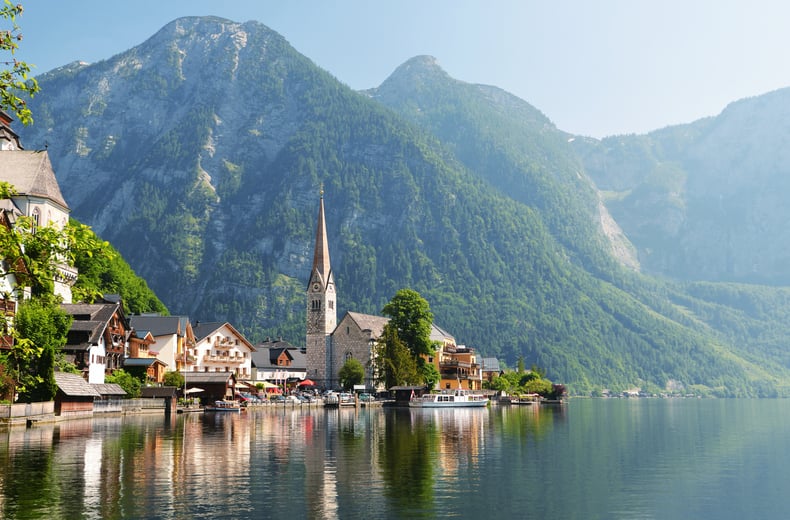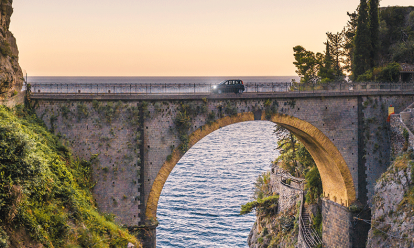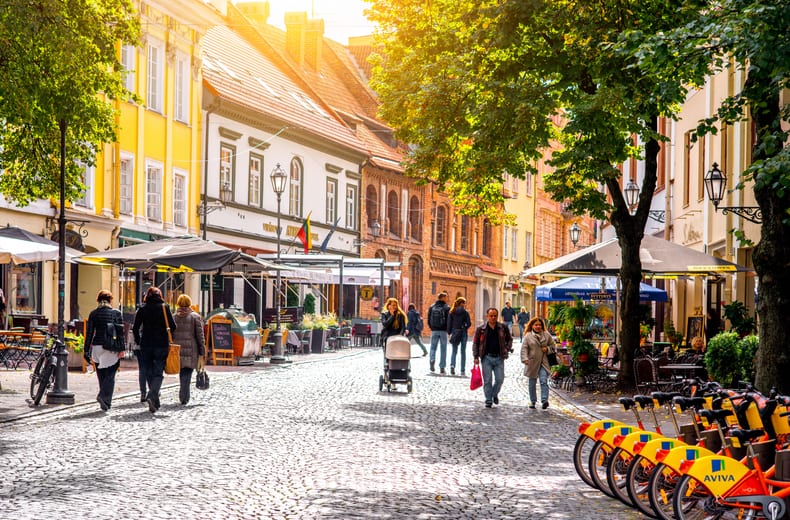Driving advice for every country in Europe
From required documents to European breakdown cover and vehicle accessories, find all the up-to-date driving laws and advice for every country in Europe in our travel guides.
Driving in Lithuania

But if you’re planning on driving to Lithuania, it’s essential you’re fully prepared ahead of time as road tripping there has many differences to the UK.
To make your trip to Eastern Europe as safe and effortless as possible, we’ve put together a guide to everything you need to know before you go, from required documents to rules of the road.
Driving a rented vehicle? Jump to the advice for driving a hire car in Lithuania section.
RAC European Breakdown Cover (Basic and Comprehensive) provides a wide range of benefits should you breakdown in Lithuania to ensure you stay safe even if you're only travelling as part of a single trip.
To supplement this, RAC also offers travel insurance. Cover will include medical expenses, baggage, personal money and belongings, among many other benefits.
Need short-term cover for your vehicle? Our temporary car insurance is perfect if you're looking for flexible cover for between 1 hour and 30 days.
Things to take when driving in Lithuania

Documents for driving in Lithuania
- A valid, full UK driving licence (you must also be 18 or over)
- Your motor insurance certificate (you must ensure your car is covered by third-party insurance recognised in Lithuania. This is the legal minimum cover for residents and visitors, so check with your provider before you travel)
- The V5 registration document for your own car or the hire car paperwork for a rental
Do I need a GB or UK sticker for driving in Lithuania?
From 28th September 2021, the distinguishing mark (or national identifier) displayed on vehicles registered in the United Kingdom that are driven abroad will change from GB to UK.
This means that vehicles registered in the UK must display the letters “UK” when driven in Lithuania.
The identifier can be incorporated in vehicle number plates (along with the Union Flag) or as a separate sticker. Note that vehicles featuring the letters GB together with the Council of Europe golden stars are no longer valid for driving abroad.
If your vehicle does not have the UK identifier within the number plate, you will require a UK sticker when driving in Italy. GB stickers will no longer be valid from the end of September.
Do I need an insurance green card?
From 2nd August 2021, drivers will no longer require an insurance green card for taking their vehicles to Lithuania.
ETIAS – 2025
ETIAS stands for the European Travel Information and Authorisation System. It is a visa program for visitors who don’t need a Schengen visa, who want to travel to the European Union and a few other European countries.
Visitors who purchase an ETIAS will be able to enter the 26 member states of the Schengen Zone as well as Bulgaria, Croatia, Cyprus, and Romania.
This will be launching in 2025. Learn more about ETIAS here.

European Breakdown Cover
Get covered when driving in Europe for just £4.17 a day*.
*Price is based on European comprehensive breakdown cover for a 14 day trip, in a vehicle up to 1 year old, travelling in zone 1.

Driving in Lithuania packing checklist
Aside from the documents above, there are some legally-required items you must bring with you to drive in Lithuania.
Unless your headlights can be adjusted, it's a legal requirement to carry headlamp converters (stickers for your headlights when driving on the right, so your lights don't dazzle motorists coming the other way).
A warning triangle is also compulsory to carry in vehicles in case of a breakdown.
It's also recommended to have:
- Spare bulbs for your car's external lights
- A fire extinguisher
- A first-aid kit
- A reflective jacket
- Winter tyres (compulsory if you're driving between 10 November and 1 April)
You can pick up all the car kit you need from RAC Shop.
Is there anything that I shouldn’t take with me?
Be aware that you cannot take the following with you into Lithuania:
- meat or products containing meat
- milk or dairy products
You cannot take the following unless you pay to have them inspected before you leave and get a ‘phytosanitary certificate’:
- fresh fruit (apart from bananas, coconuts, dates, pineapples and durians)
- vegetables
- plants
- plant products
Rules of the road in Lithuania
- Wear a crash helmet if you're riding a moped or motorcycle
- Use daytime running lights or dipped headlights day and night
- In Lithuania, you drive on the right and overtake on the left. Vehicles from the right and emergency vehicles have priority
- You do not have to call the police if you’re involved in a collision that only causes material damage. Parties involved should complete a European accident statement
- If you're caught committing a motoring offence while driving through Lithuania, you could be given an on-the-spot fine
- Seat belts should be worn in all seats where a belt is available
- Children under the age of 12 are not allowed in the front seats of cars unless there is a child restraint adapted to their size. Children under 3 must be seated in a special seat of an approved design adapted to their size
- The drink-drive limit is 0.04%. This drops to zero for novice drivers with less than 2 years’ experience. Random breath tests are carried out on all types of road in Lithuania and you must not carry an open container of alcohol inside your vehicle
Lithuanian speed limits
The speed limit is usually 50km/h in built-up areas unless otherwise indicated, while it’s 70-90km/h on country roads and 110km/h on dual carriageways. On the motorway, the limit is 130km/h – reduced to 110km/h in winter
Other things you should know when driving in Lithuania

- Winter conditions can be severe in Lithuania, so it’s essential you’re well equipped if you’re visiting in the colder months
- You won’t have to pay any tolls to use the roads, tunnels and bridges in Lithuania
- Unleaded petrol and diesel are readily available, as is LPG. A special winter diesel fuel with a very high congealing point is available in the colder months. Petrol stations accept payment by credit card
- You’re advised to use guarded car parks whenever possible as car thefts and break-ins are common
- There are parking spaces in the main towns. Some parking meters require cards, which are available from Snoras banks. Cars that are illegally parked will be clamped by the police
In an emergency
112 - Here's a really important bit of knowledge; you can dial 112 from anywhere in Europe and an operator will connect you to an emergency service in the country you're visiting.
Operators can answer your call in their native language, English or French.
Breaking down in Lithuania
RAC offers great-value, flexible RAC European breakdown cover tailored to meet your needs. We also offer comprehensive travel insurance, including cover for medical expenses, baggage, personal money and belongings.
Driving a hire car in Lithuania
Not all of the information in the guide above will be relevant to those looking to rent a hire car in Lithuania.
Though it might be a good idea to read through everything anyway, here are the most important things to know for drivers of rental vehicles:
Rental information
- The minimum age to hire a car is 21
- You need a full, valid UK driving licence and usually a second proof of ID (passport)
- Some car rental companies ask that you have held your licence for a minimum term - check with your hire company first
- Some companies require you to use a credit card for deposit
- You may not be able to drive outside of Lithuania unless planned in advance - check with your hire company first
- Make sure you get car hire excess insurance before your trip to protect yourself from unexpected costs. It's almost always cheaper to do this with a separate insurer and in advance
Hire car driving tips
- Lithuanians drive on the right and overtake on the left - the opposite to the UK
- Lithuanian speed limits are usually 50km/h in built-up areas unless otherwise indicated, while it’s 70-90km/h on country roads and 110km/h on dual carriageways. On the motorway, the limit is 130km/h – reduced to 110km/h in winter
- Dial 112 in an emergency
- It’s compulsory to wear seat belts in the front and rear seats
- The blood alcohol content limit for drivers of private vehicles is 0.04%, although this drops to zero for drivers with less than 2 years of experience


Driving in Lithuania FAQs
- Is it safe to drive in Lithuania?
On the whole, yes – Lithuanian roads are among the best in Eastern Europe. The condition of the roads in towns can be poor, however, as many are bumpy and riddled with potholes.
Take care when driving at night and be prepared for hazardous conditions if you travel to Lithuania in the winter. You should also be alert for tractors, horse-drawn carts and farm animals that sometimes pull out into the road unexpectedly.
- Can you drive in Lithuania with a UK licence?
Yes. You can legally drive in Lithuania with a full and valid UK driving licence. In addition to this, International Driving Permits are recognised but not required. Temporarily imported vehicles can stay in Lithuania for up to 90 days.
- Can you drive in Vilnius?
Yes, although driving in the Lithuanian capital can be hairy at times, particularly during rush hour, so it’s best to avoid the busiest times.
But if you have experience of driving in other European cities, you won’t find it too daunting and there are lots of interesting places to see, including the medieval Old Town with its beautiful architecture and quirky boutiques.
- Do I need a green card to drive in Lithuania?
Like the UK, Lithuania is a member of the Green Card System, a Europe-wide scheme that allows countries to recognise foreign vehicle insurance policies of visiting motorists.
UK motorists are no longer required to carry a green card to drive in Lithuania, but you should check that your policy will cover you in all countries you plan to visit before setting off.
- What side of the road do they drive on in Lithuania?
As in most European countries, motorists drive on the right-hand side of the road in Lithuania.
- Do I need a GB/UK sticker for Lithuania?
You will need to display a UK sticker on the rear of your car. GB stickers have been discontinued.
- Can I drive my car in Lithuania?
Yes, although before driving your car to Lithuania, it’s important you have all the necessary documents to stay safe and legal on the roads, including at least third-party insurance cover.
You should also ensure you have all the required items needed for your journey in Lithuania (such as a warning triangle and a first-aid kit) as well as for any other country you’re planning to drive through.
- How do I drive to Lithuania?
Getting to Lithuania by car from the UK is quite an adventure, so allow plenty of time for your journey. Firstly, you’ll need to take your car across the Channel to Calais on either the Eurotunnel from Folkestone or a ferry from Dover.
From Calais, head north east through Belgium, Germany and Poland before crossing the border into Lithuania. The drive from Calais to Vilnius takes around 21 hours non-stop.
Another option is to get a ferry to the Netherlands from Newcastle, Hull or Harwich and travel up through Germany and Poland.
- What age can you start driving in Lithuania?
To legally drive in Lithuania, you must be 18 years or older and in possession of a full valid driving licence.
- Do I need winter tyres to drive in Lithuania?
Lithuania has some very cold months, so winter tyres are mandatory on cars from 10 November to 1 April.
Spiked tyres may be used from 1 November to 9 April. Vehicles with these should display a sticker on the back representing a danger warning triangle.


UK Government travel advice
Fuel
Fuel prices in Lithuania can be found in our up-to-date European fuel prices page.
Office: British Embassy Vilnius
2 Antakalnio
10308
Vilnius
Lithuania
Telephone: +370-5 2462900
Fax: +370-5 2462901
Email: [email protected]
Website: http://www.britain.lt/
